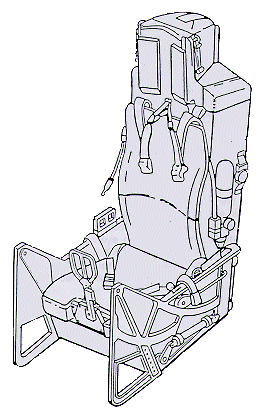The Ejection Site
The YF-22 Articulating ACES II
During the Demonstration/Validation (DemVal) phase of prototype production
for the YF-22 aircraft (produced by Lockheed Aeronautical Systems (LASC)
with partners Boeing Military Airplanes and General Dynamics Fort Worth),
a very unique ejection seat was designed. The YF-22 ACES II seat was modified
from a standard A-10/T-46A version to have a particularly unique feature. In
modern combat with the extremely dynamic manuevering ability of new aircraft
the pilot must be able to survive and be in control of the aircraft while
being exposed to rapid and high changes in G-force. There are two traditional
methods of dealing with this problem. One is the use of the combined anti-g-suit
and g-straining manuever (which involves a physical tensing of certain
muscles while breathing in a certain manner), the other is placing the seat
in a reclining posture. Both methods were examined by the project teams, with
a new style anti-G-suit being issued for the former, and the modification to
the ACES II seat for the latter.
 The concept was simple (as so many
engineering concepts are), but required much work to develop. The seat was to
be installed in a traditional semi-upright posture with a seat back angle of
15 degrees, but to have the ability of changing the seat back angle to 55 degrees
either by the pilots choice, or possibly automatically selected by the flight
control computer at the onset of rising Gz. Many factors had to be considered
during the design phase, including:
The concept was simple (as so many
engineering concepts are), but required much work to develop. The seat was to
be installed in a traditional semi-upright posture with a seat back angle of
15 degrees, but to have the ability of changing the seat back angle to 55 degrees
either by the pilots choice, or possibly automatically selected by the flight
control computer at the onset of rising Gz. Many factors had to be considered
during the design phase, including:
- How to maintain the design eye position.
- How to maintain throttle and stick pilot interfaces during articluation.
- What type system should be utilized for retraction prior to ejection.
- How would rudder pedal repositioning be accomplished in concert with seat
articulation.
This is only a sample, many other factors were considered as well.
Weber Aircraft was chosen at the vendor to provide
the seats. The seat as built was a fairly standard seat with B-2 style flip
up pitot sensors, new machined
side panels, a hinged/rotating back panel, moving seat pan, modified
survival kit, lap belt tension adjustment, and the articulation/retraction
system. The articulation system used a electrical motor to drive the seat
pan up and forward, pulling the seat back with it. The motor drive was coupled
by a drive shaft to the rudder pedal adjusting mechanisms. The seat back was
hinged at its upper end, directly behind the pilot's shoulders. This arraingment
was developed by intensive evaluation with mockup and human subject evaluation
at General Dynamics.
The net result was that at the choice of the pilot (The automated system being
defered), the seat pan could be adjusted so that the seat back angle was any
position between 15 and 55 degrees. This allowed the pilot to almost lay prone
in the aircraft during high-G manuevering, but resume an upright position for
other flight duties. In the event of an emergency requiring ejection while the
seat was in the reclined mode a pyrotechnic retract mechanism was included
in the design. It was this mechanism which delayed the use of the articulation
until late in the program. This system was designed to retract the seat to the
15 degree upright posture in 30-700 milliseconds and was integrated with the
center pull ejection handle. The seat was eventually fully cleared for
articulated use except during takeoff and landing.
Pilots reports were generaly positive, especially in regard to seat comfort with
the seat in the 34 to 45 degree position. There were concerns, however with such
details as increased difficulty in 'checking 6', and reaching certain controls.
There also were some safety concerns raised by reports that the ejection handle
blocked some portion of the lower multi-function display with the seat reclined,
and one pilot reported that his knees contacted the underside of the instrument
panel (this occured while the seat was fully reclined and the pilot raised
the seat to get better visibility).
Overall, the minimal time to test the complete system, and the added costs,
weight, and complexity caused the seat to be omitted from the final design.
Hopefully, the concept of escape system articulation will be examined again
in the future as it could provide for improved pilot capability and comfort.
Information and diagrams for this page taken from
"The YF-22 Articulating Ejection Seat" by Gordon P. Cress, Lockheed
Aeronautical Systems Company. A paper presented to the SAFE organization.

 The concept was simple (as so many
engineering concepts are), but required much work to develop. The seat was to
be installed in a traditional semi-upright posture with a seat back angle of
15 degrees, but to have the ability of changing the seat back angle to 55 degrees
either by the pilots choice, or possibly automatically selected by the flight
control computer at the onset of rising Gz. Many factors had to be considered
during the design phase, including:
The concept was simple (as so many
engineering concepts are), but required much work to develop. The seat was to
be installed in a traditional semi-upright posture with a seat back angle of
15 degrees, but to have the ability of changing the seat back angle to 55 degrees
either by the pilots choice, or possibly automatically selected by the flight
control computer at the onset of rising Gz. Many factors had to be considered
during the design phase, including:

